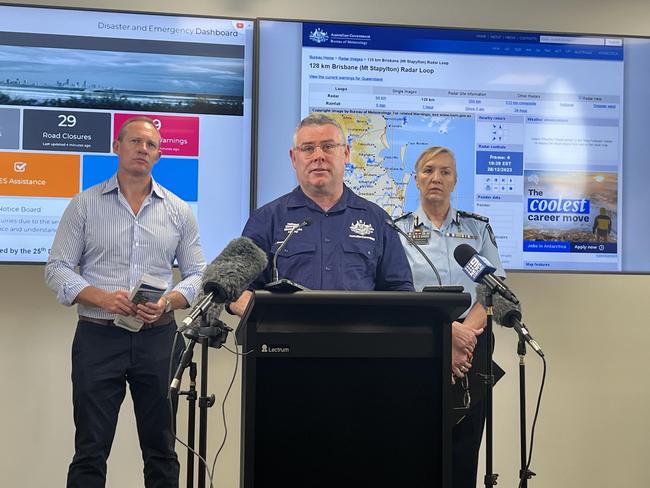BOM review ordered after widespread backlash
As the federal government launches a review into how the national emergency warning system operates under BOM, the state’s disaster response leaders have revealed how the system can fail in fast-moving storms.
QLD weather news
Don't miss out on the headlines from QLD weather news. Followed categories will be added to My News.
A review of how the national emergency warning system operates following widespread backlash at the Bureau of Meteorology’s communication of deadly weather events in Queensland has been welcomed by the state’s disaster response leaders.
Emergency Management Minister Murray Watt said on Friday there “seem to have been an issue” with how emergency alert messages have delivered warnings this month ahead of the flooding catastrophe in the Far North and freak Christmas storms in the South East.
Gold Coast Mayor Tom Tate echoed the fury of flooding victims and farmers this week when he blasted the bureau’s inadequate warning of the storms as “unforgivable”.
But Senator Watt stood by the federal agency’s predictions of the deadly weather events and blamed the state governments and councils, who he said needed to share warnings from the BOM “as quickly and clearly as possible”.
“The BOM issued warnings of life-threatening floods and severe storms for days leading up to the FNQ floods and SEQ storms,” he said.
“There does, however, seem to have been an issue with the communication of that information by emergency alert text messages.
“Generally speaking, emergency alert text messages are sent by councils and if all levels of government can work together to improve the flow of those messages, that will better protect residents from extreme weather.”

Senator Watt said he had asked the National Emergency Management Agency to work with state governments and councils to ensure warnings and weather information from the BOM was “shared and interpreted as clearly as possible”.
“Sometimes weather patterns are unpredictable, but where information about conditions is available, we expect that to be shared as quickly and clearly as possible,” he said.
Premier Steven Miles and State Disaster Coordinator Shane Chelepy said on Saturday criticism of local councils not pushing out the Bureau’s warnings in time was not fair given how quickly some storms had formed over Queensland recently. In once case the storm occurred within 15 minutes.
“We always want to keep getting better and that’s been our approach to the disaster response in Queensland since 2010, after every disaster we have reviewed and sought to get better and that’s why we have the best disaster system in the world,” Mr Miles said.
“The weather events we are seeing are changing. If there are ways we can improve our alert systems either with better technology, or by inputting these kinds of weather events we are seeing into the models the Bureau uses, then I think it is a good thing.”

Deputy Commissioner Chelepy said recent storms had formed so quickly in parts of the state that getting alerts out through every available channel was not possible.
“Our warning system is a tiered approach so the Bureau of Meteorology puts out alerts, the State Disaster Coordination Centre also pushes out emergency alerts via telecommunication networks,” he said.
“Then at the local level, we have the Australian warning system which allows local governments (councils) to push out and amplify that messaging through their local disaster management networks.
“When we see a storm that moves through an area like we saw this morning (Saturday) in the Wynnum/Cleveland area that formulated within 15 minutes, I think it is unreasonable to think that a tiered approach will hit every one of those platforms.
“That’s why sometimes only an emergency alert or a BoM warning can get out (in time).”
Mr Tate said he welcomed the review, but hit back at criticism of the council’s own storm messaging service.
“I support the bureau and the important job they do,” he said. “However, while storms are unpredictable, it is vital that they get this messaging right because lives can literally depend on it.
“It was great that Murray came to the Gold Coast this week to show federal support and extend hardship payments to those eligible, (but) council is not the lead agency on weather warnings and we do not employ meteorologists.
“Yes, we forward warnings received from other agencies as part of disaster arrangements but let’s be clear – this was a mega storm that has been compared to a category 2 cyclone in intensity.
“The precise warnings were too little and too late and that’s disappointing.”
Premier Steven Miles and Prime Minister Anthony Albanese defended the bureau after residents in the Far North were blindsided by the flooding disaster and hundreds were left stranded on roofs.


